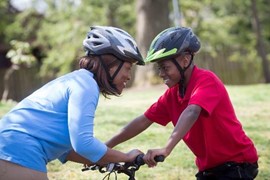(Media release from AAA – The Auto Club Group):
May is National Bicycle Safety Month, which reminds Georgians to examine their habits as drivers and riders to safely share the road. Unfortunately, injuries and deaths from bicycle crashes continue to be a serious problem in many states. According to the National Highway Traffic Safety Administration (NHTSA), in 2022, nationally there were 1,105 bicyclist fatalities and an estimated 46,195 injuries. In Georgia alone, within the last 10 years from 2013 to 2022, there were 241 fatalities. Bicyclist deaths are highest during the summer months between June and September. This heartrending statistic is primarily due to cycling enthusiasts taking to the lanes in greater numbers, driven by the allure of summer’s warmth.
“Drivers and cyclists play an equal part in sharing the road, outdoor activities are on the rise,” said Montrae Waiters, spokeswoman, AAA – The Auto Club Group. “School-aged children are spending more time riding their bicycles, and Georgia law states children 16 years and under must wear a helmet. Unfortunately, not everyone does. A good rule of thumb to remember is that every bike ride should begin with putting on a helmet. Preventable deaths are the goal, ride responsibly.”
Regardless of age, AAA encourages all bicyclists to wear a properly fitted bicycle helmet every time they ride. A helmet is the single most effective way to prevent head injuries resulting from a bicycle crash.
Finding the Right Fit
- Bicycle helmets should fit comfortably and snugly, but not too tight.
- It should sit on your head so that the front rim is just above your eyebrows.
- If the helmet rests farther back, your forehead will be exposed, providing less protection from head injury.
- Before buckling the chin strap, shake your head from side to side. If the helmet turns or slides, it’s too big and won’t protect your head no matter how tight you pull the strap.
- When your chinstrap is buckled, open your mouth, and feel the helmet press firmly against the top of your head.
Bicyclists
- Ride on the roadway or shared pathways, rather than on sidewalks.
- Follow the same rules of the road as other roadway users, including riding in the same direction as traffic and following all the same traffic signs and signals.
- Signal all turns.
- Wear a bicycle helmet every time and on every ride. Nearly all bicyclists who died from a collision were not wearing helmets.
- Be visible by wearing bright colors during the day, reflective gear in low light conditions, and using head and taillights at night.
- Remember that respect is a two-way street. Show motorists the same courtesy that you expect from them.
Motorists
- Stay alert—avoid all distractions while driving.
- Yield to bicyclists when turning.
- In bad weather, give bicyclists extra passing room, just as you would other motorists.
- Make a visual check for bicyclists by checking mirrors and blind spots before entering or leaving a lane of traffic.
- Slow down and give at least 3 feet of clearance when passing.
- Reduce your speed when passing bicyclists, especially when the road is narrow.
- NEVER honk your horn at a bicyclist—it could cause them to swerve into traffic or off the roadway and crash.
- Always check for bicyclists before opening your car door.
- Children on bicycles are often unpredictable—expect the unexpected.
For more information, download AAA.com/aaabike.
